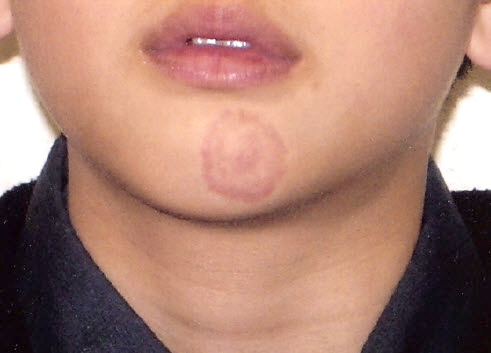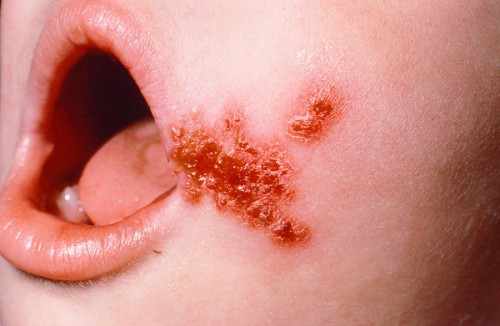Diseases Parents Should Know, 9 – Flu, Impetigo, Ringworm
As much fun as this has been romping through the memories generated by reviewing the “second brain” notebook I used all through medical school and residency, I think that we might be nearing the end of this series: Child Diseases Parents Should All Know About.
Child with Impetigo at common locationPerhaps, however, we’ll just make it a round number for the good ‘ol OCD’s sake then call it done for this series.
We’ve kind of had fun, haven’t we? And we’ve found that most of the terribly deadly child diseases which can cause mass epidemics, now have a way to wipe them out – if we would but use it.
Still More Child Diseases To Know
Impetigo, Ringworm and Influenza
Some of the diseases are diagnosed by their rash and today we’re going to talk about two that are so common you’ve probably had them yourself, more than once.
The first disease I’ll mention in part 9 is so common that I never go into a store or crowd of any size without spotting at least one or two children who have it – and perhaps are NOT being treated: Impetigo.
Impetigo
Impetigo is another bacterial skin infection, like the MRSA we talked about last time, except it’s the third most common skin condition in children over all – just behind dermatitis and warts. It is highly, highly contagious but only through direct contact; however, that’s not much help because kids touch almost everything, everywhere.
Which explains why children 2 – 6 years old are highest peak of the illness even though the stuff can attack all ages and genders – anywhere there is a slightly broken piece of skin where it can get a foot-hold.
 Boy with nonbullous Impetigo on faceOnce started, Impetigo spreads into clusters of oozing, weeping, crusting, honey-colored sores with fluid which can get on rags, linens, hands and about any other object. Touching any of those things can spread it around the family, school, nursery and neighborhood.
Boy with nonbullous Impetigo on faceOnce started, Impetigo spreads into clusters of oozing, weeping, crusting, honey-colored sores with fluid which can get on rags, linens, hands and about any other object. Touching any of those things can spread it around the family, school, nursery and neighborhood.
The bacteria culprits are: group A beta hemolytic streptococci (of strep throat, scarlet fever, rheumatic fever and kidney disease fame) and Staphylococcus aureus OR both – much of the time strep starts the fight then passes the ball to staph.
HERE’S THE BOTTOM LINE:
A—Although, in some cases (13-50 percent) Impetigo will heal on its own (over 7 to 21 days), it is NEVER wise to let it do so (for multiple reasons below).
B—Impetigo is a BACTERIAL disease, nearly always caused by a “Strep” related organism which, if left to do so, will cause the body to generate antibodies to kill it beginning in about 5 to 7 days. Trouble is that those antibodies can also “attack” your own joints, heart valves, kidneys and other organs! It’s called Rheumatic Fever which took a great deal of trouble to find out and develop a “cure” for: we try NEVER to let the body fight a strep infection on its own if we can help it, we use antibiotics.
C—Keeping it clean doesn’t have to be with anti-bacterial soap but washing outward can spread it all over the body. Always wash carefully inward.
D—Ointments can make it feel better but DO NOT cure it! Antibiotic ointments are OK for initial treatment if they help within 3-4 days.
E—Fragrances and other additives in ointments will almost always make it harder to heal. NEVER use alcohol on a weeping rash like this; and oils, even the “essential” kind are worse than plain ol’ Petroleum Jelly (which stays longer, means less fussing and doesn’t create skin allergies.
[I’m the type of physician who always has been very judicious with antibiotics (even back when doing so wasn’t popular) but this is one time where we’ve learned that it’s NOT good to “go natural” and play Russian Roulette with the consequences of the disease.]
There are other significant problems with letting them go it alone too:
1) You have to look at a scabby face for nearly a month – which you’ve here-to-fore always and fondly considered really cute;
2) The longer it goes, the more likely it will spread to the rest of the body (even in older kids, who always wash hands AFTER going to the bathroom, instead of before like needed to prevent spread);
3) The longer it goes, the more likely it will spread to YOU and others;
4) The longer it goes, the more risk of complications like spreading deeper (especially with MRSA);
5) The poor kid will probably be sent home from school as a contagion to others (remember I said it was highly contagious); and
6) really, Antibiotics are easily available.
With appropriate treatment, prescription antibiotics or ointments, the sores usually resolve in 3-10 days without any scaring and have nearly eliminated the term “Rheumatic Fever” from our vocabulary. If lesions persist beyond that point, your pediatrician will look for resistant organisms, which may be the case in patients with eczema or an underlying parasitic infection.
Ringworm
 Boy with ringworm on chin – Tinea CorporisHow this disease got its name is anyone’s guess. It sometimes is a “ring” (sort of) but it has absolutely nothing to do with “worms.” Ringworm is a skin infection caused by a fungus – many different kinds.
Boy with ringworm on chin – Tinea CorporisHow this disease got its name is anyone’s guess. It sometimes is a “ring” (sort of) but it has absolutely nothing to do with “worms.” Ringworm is a skin infection caused by a fungus – many different kinds.
It’s an itchy, red, scaly, oozie, blistery, patchy rash with usually sharply-defined edges in a (sort of) circular pattern that is paler in the center and looks like a ring. It is easily spread from person to person just by touching them OR even just touching something they’ve touched.
Sharing combs, brushes, towels, clothing, shower, tub or pool surfaces is not a good idea AND you can get it from pets, especially cats, who carry the fungus – remember they, just like dogs, roll around in everything.
The fungus (plural fungi) just loves warm, moist areas (like when you are often wet, i.e. sweating) and gets a jump start in minor injuries to your skin.
Ringworm has a different name for each area of the body it infects. On the body it’s called “Tinea Corporis.” In the beard, “t Barbae”; on the scalp, “t Capitis”; the groin, “t Cruris” (jock itch); and the feet, “t Pedis” (athlete’s foot). They are all treated with antifungal medication along with various methods of keeping the area clean and dry.
Influenza (Flu)
I don’t have much to add here because we’ve written extensively about Colds vs. Flu previously.
Perhaps three things to add would be that:
1- Influenza, the ONLY disease “authorized” to be called “flu” does NOT normally have anything to do with vomiting or diarrhea; and,
2- There is NO SUCH DISEASE as “stomach ‘flu'” – it’s called gastroenteritis; and,
3- These days pretty much EVERYONE should seek and receive a “flu shot” every year – EXCEPT those individuals where your doctor has advised against it due to some illness or condition (ask your doctor if there is any contraindication for you).
It is caused by a virus and as such, once you contract it we have no medication which will “kill it” and almost none that will slow it down. We do have a shot which will PREVENT it, if it’s against the same strain that is attacking people this particular year (it does often change); and, if you take the shot before being exposed.
That’s pretty much it for this disease.
– – 0 – –
The thought does occur to me that perhaps one of you might have a particular disease you think should be on the “Child Diseases All Parents Should Know” list. If so, first use the search box above to check if there’s already been an article written; and then go ahead and use the “contact” link below to shoot us an email.
The “Good Lord willin’ and the creek don’t rise,” we’ll probably make an end to this nostalgic walk in the next post. See you then.
11 Posts in Childhood Diseases (childdiseases) Series
- Part 10 - Lyme - Allergies – 9 Oct 2014
- Part 9 - Impetigo - Influenza – 1 Oct 2014
- Part 8 - Polio - MRSA – 23 Sep 2014
- Part 7 - Meningitis - Scarlet Fever – 11 Sep 2014
- Part 6 - Diptheria - Tetanus – 3 Sep 2014
- Part 5 - Varicella - Rubella – 18 Aug 2014
- Part 4 - Rotavirus - Kawasaki's – 10 Aug 2014
- Part 3 - Hand, Foot, Mouth and Fifth disease – 29 Jul 2014
- Part 2 - Otitis, Glue ear – 21 Jul 2014
- Part 1 - Croup, Bronchiolitis – 17 Jul 2014
- Childhood Diseases Parents Should Know: Intro/Index – 15 Jul 2014
Advertisement by Google
(sorry, only few pages have ads)

